What do you think of when you think of Germany? If it’s mountains (or at least rolling hills), Oktoberfest, castles, and lederhosen … well, those things that are all part of Bavaria. Last weekend, we received our first taste of Bavaria when we visited Anna’s long time friend (and someone I had heard so much about), Gabi and her family in Franconia (a part of Bavaria, or Bayern in German). She says it’s a very “special place” and was the one who pointed out to me that all those quintessential “German” things are actually Bavarian. We learned that they are a justifiably proud people who had an autonomous government until 1871 when Prussia won the Franco-Prussian war and the German states (including Bavaria) proclaimed their union under Prussian rule. This is after Bavaria had been defeated along with Austria in the Austro-Prussian War a decade before, where Prussia was deemed the aggressor. So, with that short history lesson, let me introduce you to our friend, Gabi, and the rest of her family. 🙂
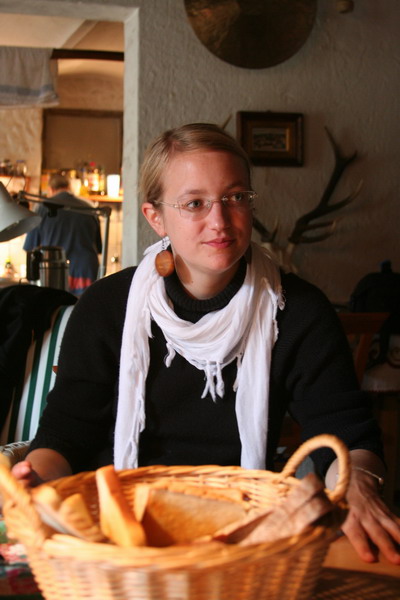
These pictures are apropos as we spent many hours around the table catching up (as was the case for Anna and Gabi) and getting to know each other (for the rest of us). This is Gabi’s mother preparing one of the delicious meals we shared with them.
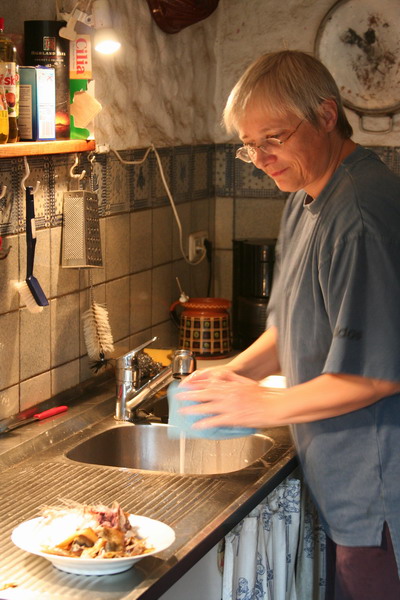
It was a great experience to stay with them. Their family owns a farm and many of the things we ate were either produced there or somewhere in the local area (plus her father is a hunter/fisherman … not an easy task in Germany). Being aware of where your food comes from was something that I often neglect (as I suspect most Americans do). However, that was not the case there. It was an interesting lesson to hear the virtues of knowing more about your food. Here is a picture of Gabi’s father.
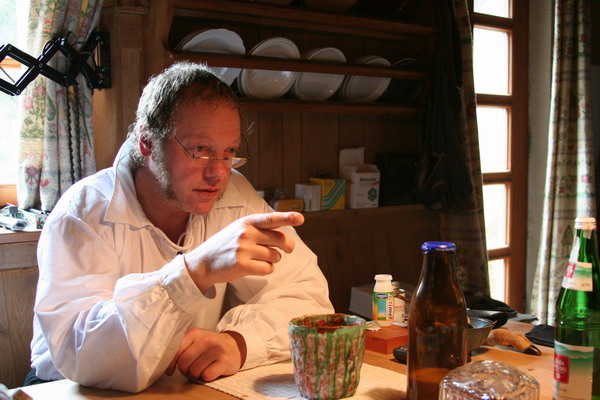
While Anna wasn’t quite sure, at first, about the food recommendations that Gabi made, everything we tried at her house was delicious! I have to say, even though I love Wisconsin cheese … European cheese is WONDERFUL!
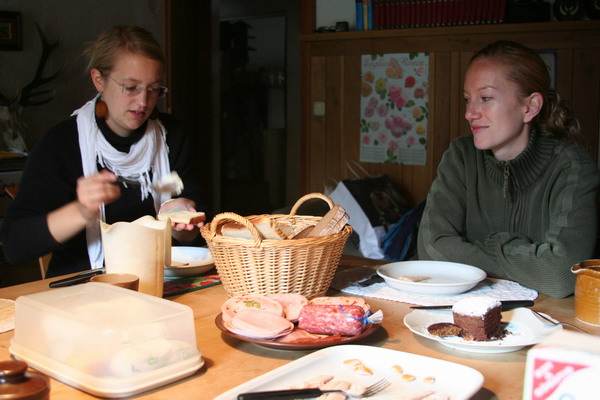
This image shows Gabi’s boyfriend, Phillip. He and Gabi met at the university and have now been dating for several years. They were very cute together, plus it looks like he fits in seamlessly as part of her family. Anna and I were very thankful that all four of them could speak English very well. Our German is progressing (albeit slowly) and if we would have had to rely on that, virtually nothing would have been communicated! It was also cute to watch as her father went from a little unsure of his English skills (he hadn’t spoken English in a while), to completely fluid by the end of the weekend.

Here is another image of her mother.
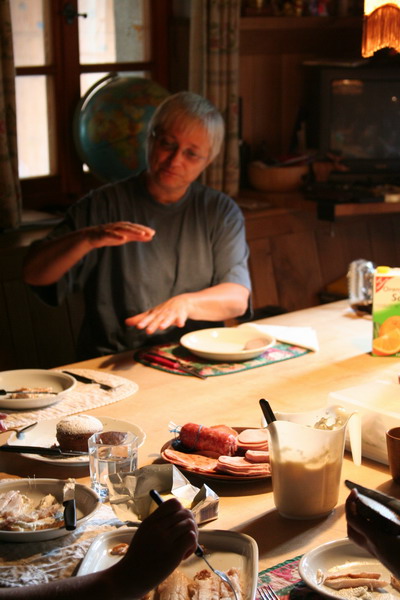
Of course, no trip would be complete without a little adventure, right??
Well, there is no shortage there. We got to visit a couple castles, a crypt and a beautiful opera house built by a princess.
Here was the crypt. As you can see, at some point, someone decided that all the bones should be neatly stacked up in the entranceway. I don’t know who that was, nor why, but it certainly made for an interesting sight.
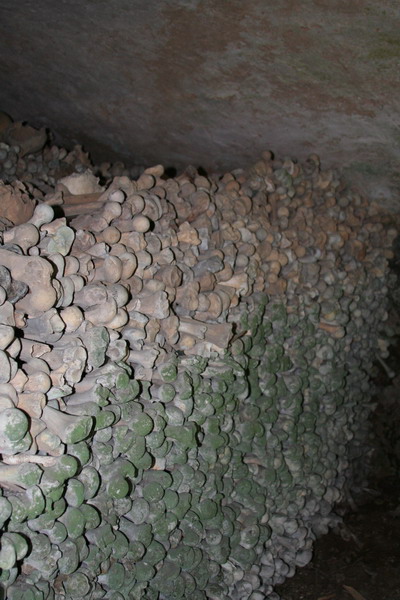
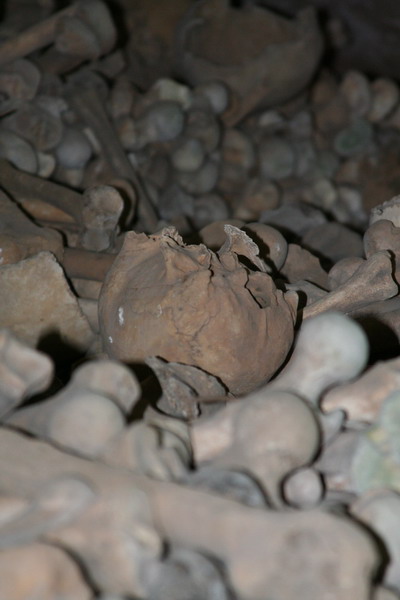
This is the opera hall built in the mid 17th century by the Prussian Princess Wilhelmine of Bayreuth. She was the sister of Frederick the Great, the “Enlightened Despot.” Both Frederick and Wilhemine were close to another savant of the time, Voltaire. This friendship was a powerful influence on them personally and the building she created.
We learned much watching a video that details the history of the theater. While it was in German, Gabi was kind enough to offer us a translation. Here is the interior of the exquisite main hall.

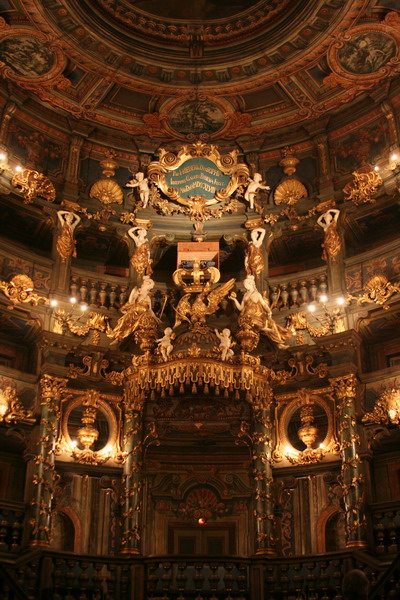
With that stunning display of 17th century architecture, we bid Gabi and her lovely family farewell. We can’t wait until we go back again and explore more. Yes, Gabi, Bavaria certainly is “special.”
So, until our next adventure…
–Jim
Month: November 2006
Trier — the oldest city in Germany
OK, so, I know it’s been too long since my last post. For those of you who read the site regularly, my apologies. Since we just moved into our new house, it’s been a bit crazy, as you can probably imagine!
However, a couple weeks ago, we took our first “true” foray into the local culture with a trip to Trier, purported to be the oldest city in Germany. It was a provincial capital in the Roman Empire and the only city this far north. It’s a trip that’s offered to everyone when they arrive here. It’s a great way to get a guided perspective on the area and learn some basics and how to get around (we took a train into Trier).
Here is the gate of the city, Porta Nigra. It’s so called from the ages of fires that have blackened the stone. It was the city gate in Roman times.
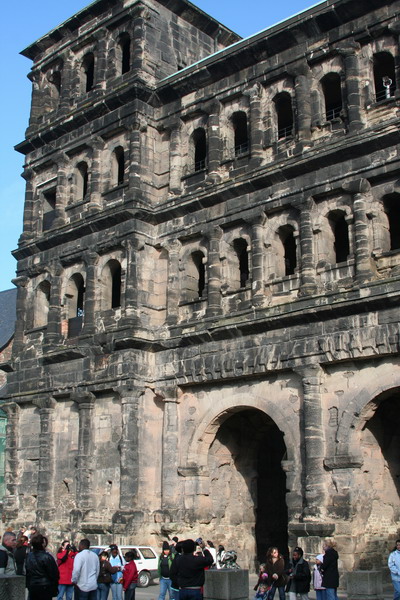
This is our guide, Easter, who did a wonderful job showing us around the city.

You can see, she kept everyone raptly enthralled. 🙂

The market in the center of town had many great sights.
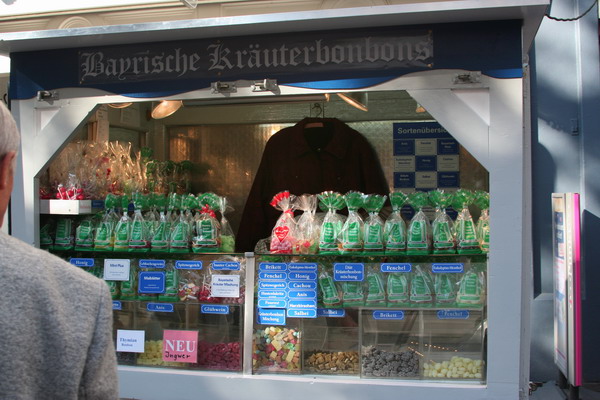
This couple was so cute.
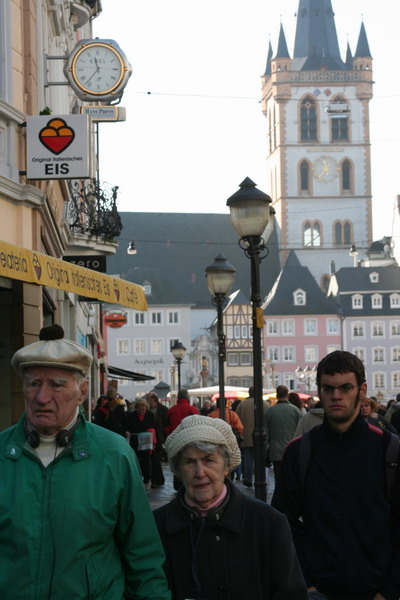
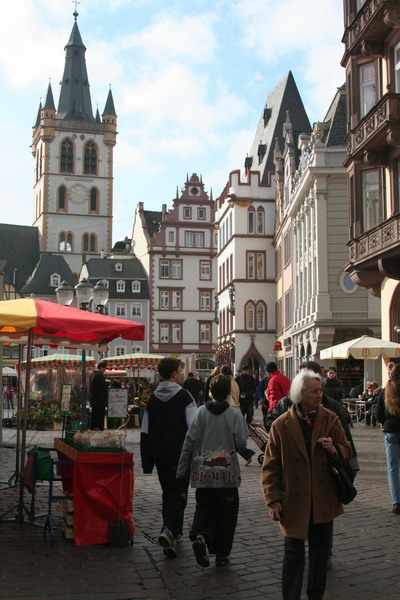
This is the Jewish Alleyway. Before the war, there was a large Jewish population here. It hasn’t recovered.
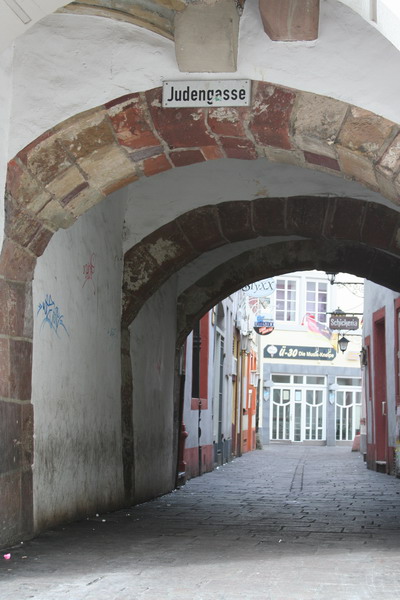
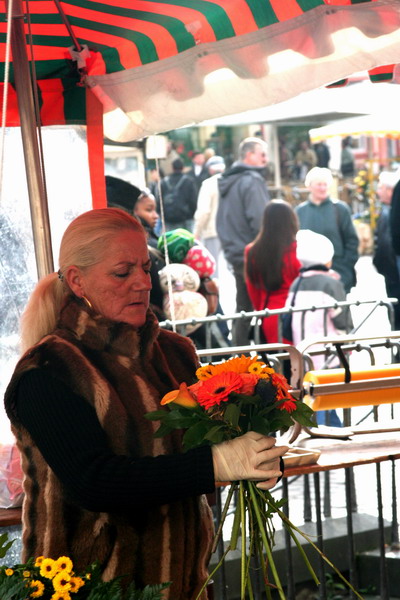
This baroque sculpture shows that artists then certainly had a sense of humor. This piece survived both world wars (the second because the town dismantled it and brought it to the country to protect it from the bombing). If you look closely though, you’ll see behind the women, there are a couple monkeys doing very naughty things. Our friends here refer to it as the Dirty Monkey Fountain.
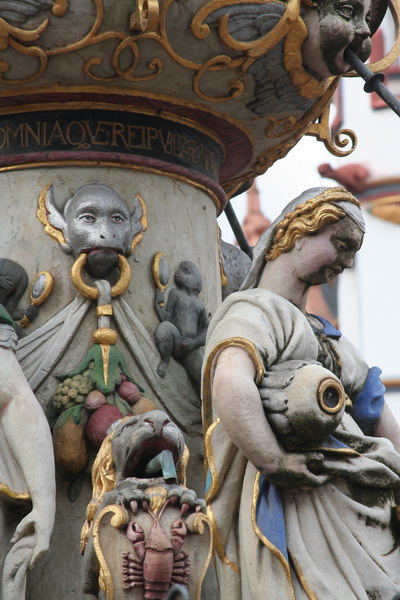
Although McDonald’s has invaded, there are rules (at least here) on how large the “Golden Arches” can be.
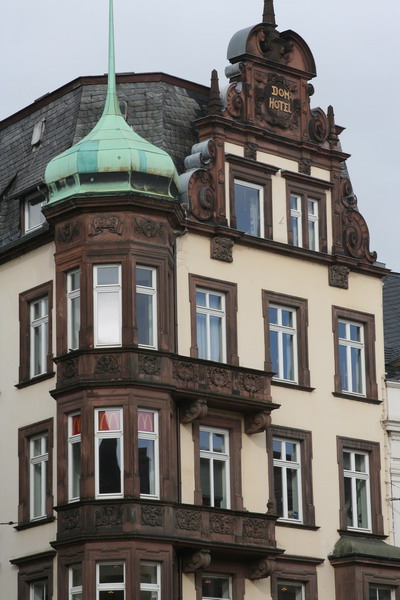
We ate lunch at an ancient restaurant. In fact, they recently excavated the basement. In doing so, they came across a huge number of priceless Roman artifacts. They have them on display in the restaurant. Included is this cookbook (although I don’t think it was actually excavated). Supposedly, this is the oldest printed cookbook in existence (printed, not written). It was printed in 1498 on a Guttenberg printing press and contains Roman recipes that are 2,000 years old! Also, every week, the restaurant cooks dishes made from recipes in here.
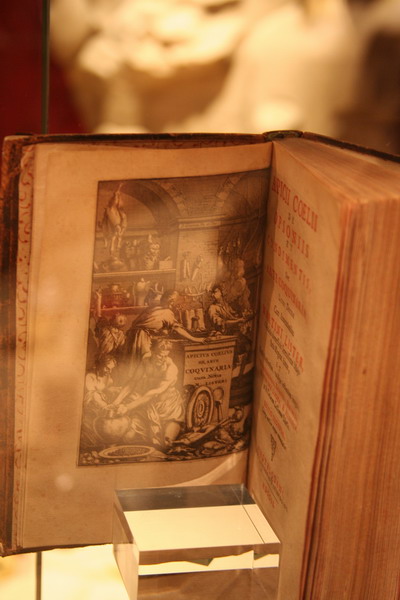
This relief was excavated.
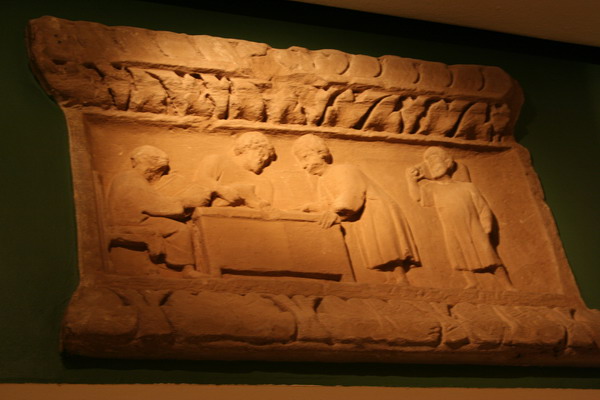
Next, we visited a couple cathedrals.
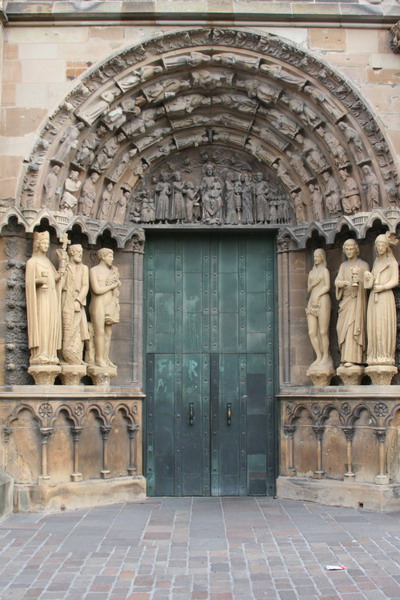
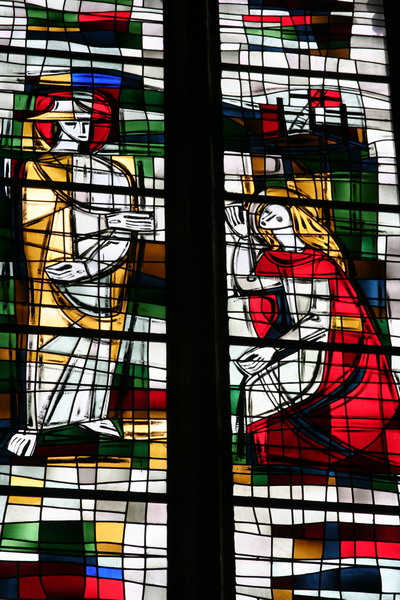
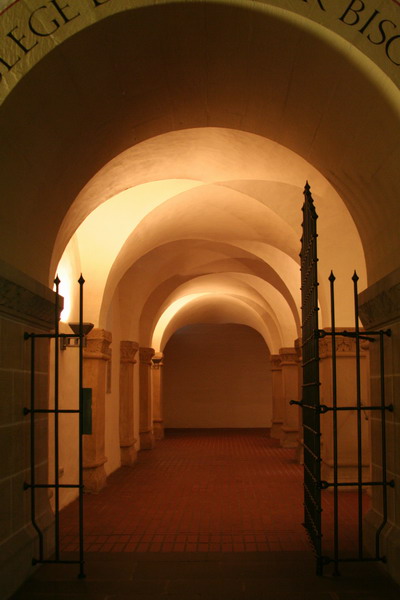
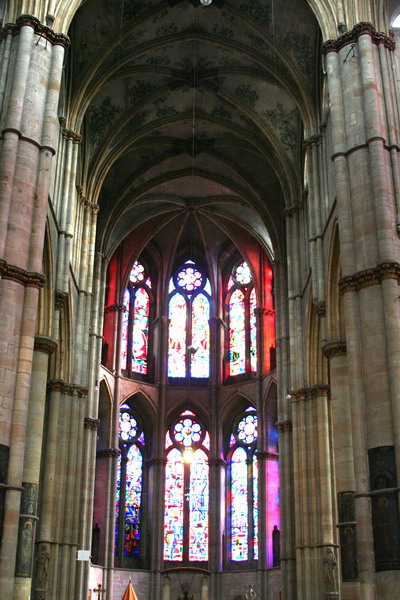
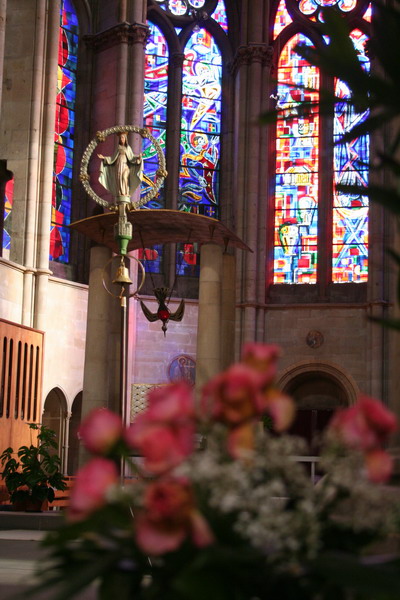
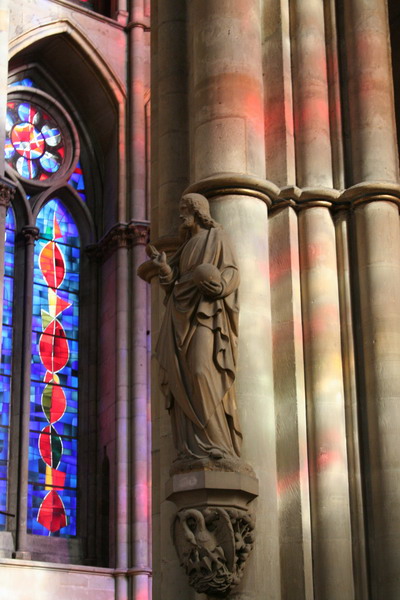
Another interesting fact about Trier was that it was the seat of the Roman Emperor for a while. If you recall your European history, Constantine (who coincidentally made Christianity the state religion of Rome), was born and grew up here. This is an image of the building that was his throne room.
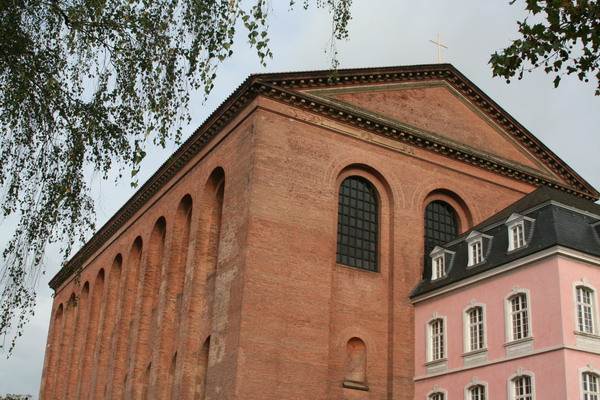
While the inside was completely gutted during the Middle Ages (nearly a whole village lived inside for a while), it’s now used as a protestant church.
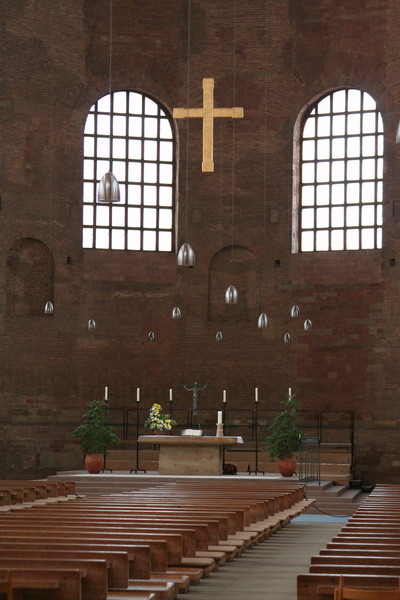
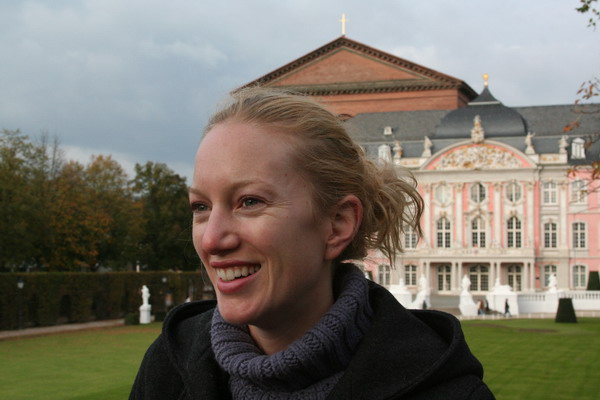

That finished our tour of the historic city of Trier. We loved getting to visit someplace so fascinating and now, so close! It’s a taste of what’s to come for the next few years and we are excited!!
Until the next adventure…
–Jim
Paris, the city of romance…
Last weekend, in celebration of Anna’s birthday, we took a road trip down to Paris. It’s about a four hour car ride and since we didn’t have a car then, our friend Jose was VERY generous and let us borrow his (including the GPS navigation), which made the trip much more enjoyable. 🙂
Although I have been to France a couple times before, it was Anna’s first time. So, we focused our short two-day stay on the big tourist destinations (that seems to be the case the last few trips … hopefully, we will be able to delve in a little deeper next time).
One of the great romantic icons of the world is the Eiffel Tower. We watched darkness fall over the tower with many other couples. Love seemed to be in the air throughout the whole city. 🙂
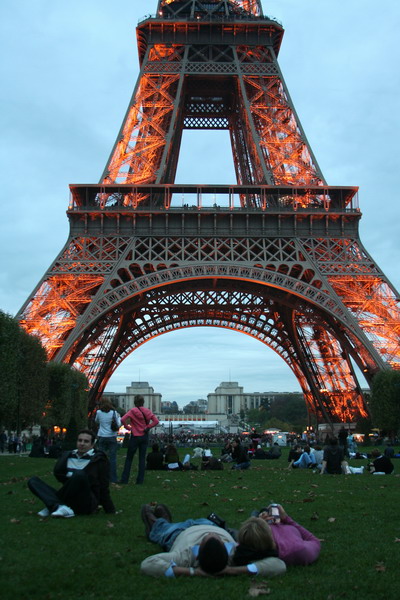
For the millennium celebration the French government placed strobe lights on the tower, and on the hour when it gets dark, they illuminate the sky. It’s very pretty (although perhaps a bit gaudy, but that has characterized the Eiffel Tower since it was built in 1889, when it replaced the Washington Monument as the world’s tallest structure).
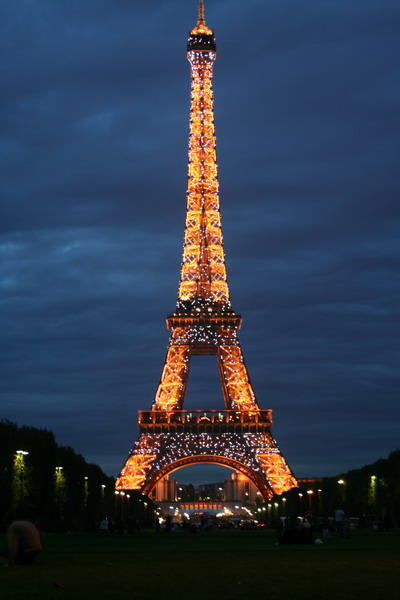
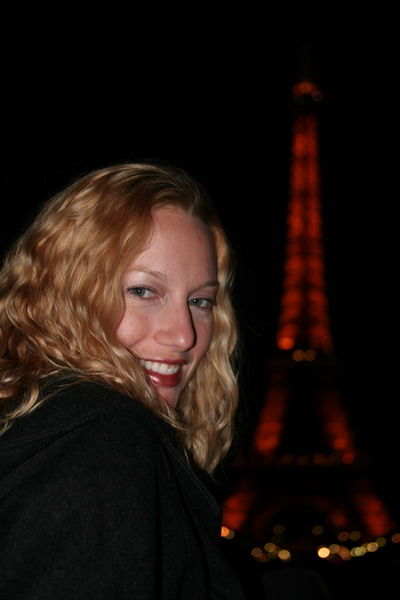
Next stop was Napoleon’s famous Arc de Triomphe on the Champs-Élysées. An interesting fact: when Napoleon returned to Paris in 1810 with his bride, Archduchess Marie-Louise of Austria, he had a wooden mock-up of the completed Arc built as a wedding present.

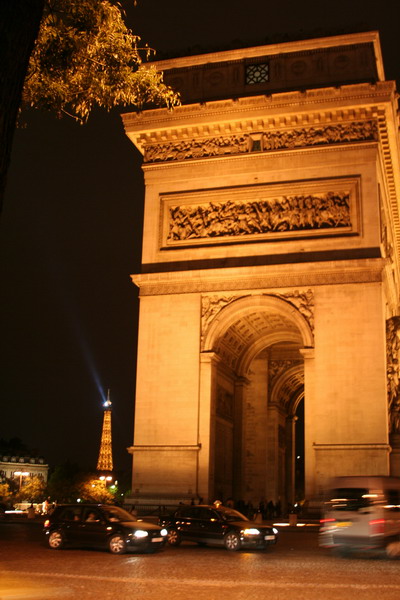
After an exquisite dinner at Ladurée on the Champs-Élysées, we walked up the boulevard to purportedly the most famous cabaret in the world, The Lido. For those of you who aren’t familiar with it (we’ve found most Americans aren’t), it’s a show similar to the Moulin Rouge. It’s a bit risqué, but the costumes and sets were beautiful. We enjoyed the show, but it’s a bit expensive and we recommend the Moulin Rouge instead.
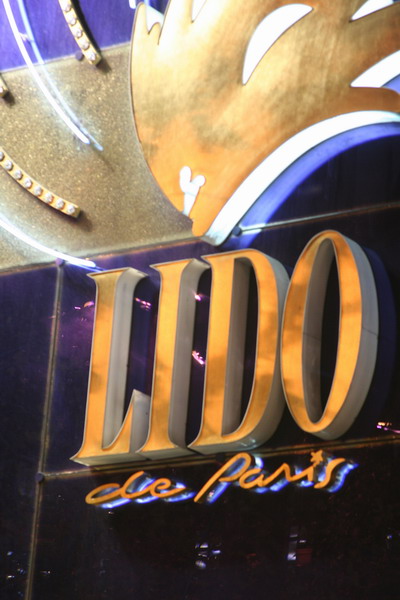
A view looking back up at the Arc from the Champs-Élysées.
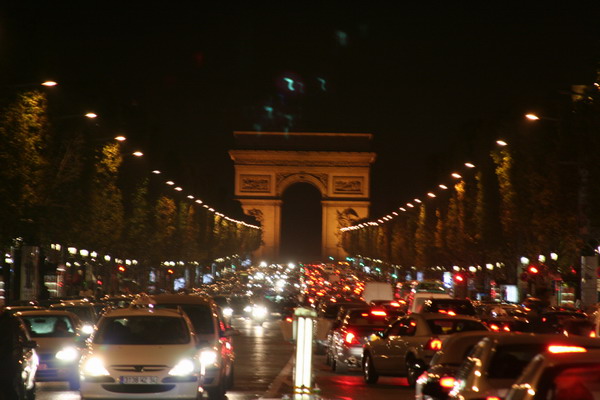
Here is the view from our hotel balcony. It was in a perfect location, literally right next door to the Louvre and close to all the sights we wanted to visit.
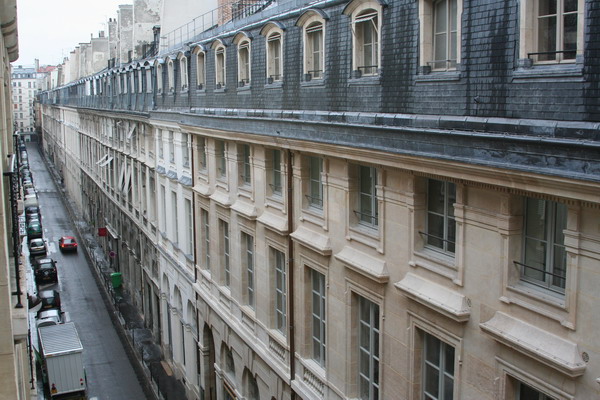
Of course, one of the best parts of being in Europe (and Paris in particular) are the outdoor cafes. You can wake up and walk over to indulge in a hot chocolate (or coffee) and croissant. In Guam, it was waking up and walking down the beach for waffles. I don’t know which I like better, but the chocolate and croissant tasted fabulous on a cool, overcast morning here.
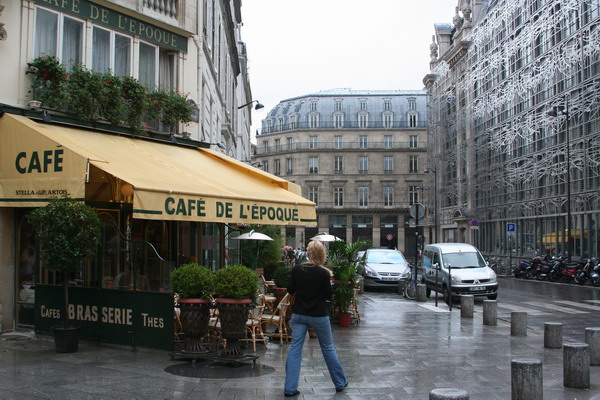
After our petit-déjeuner, it was across the street to spend the day at the Louvre. As you can see, the weather was perfect for museum exploring.
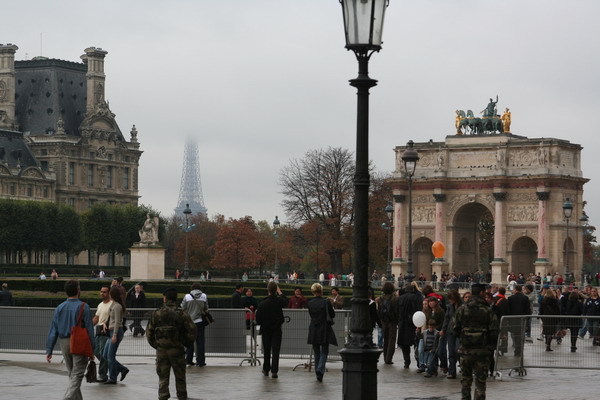
The line was a little long to get in (and a bit wet), but fortunately, we were admitted inside quickly.
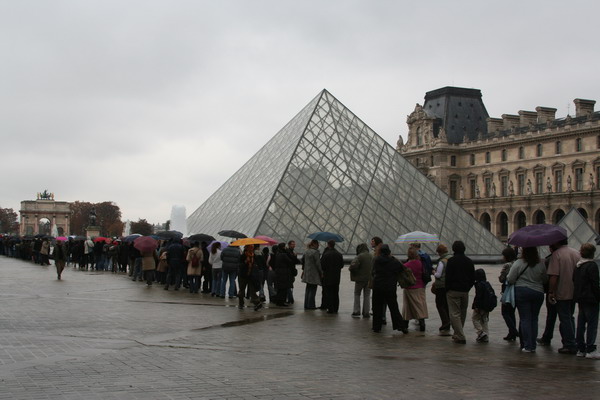
Below are a couple pictures of a fashion that was very popular in France. It’s here in Germany too, but not quite to the same extent.

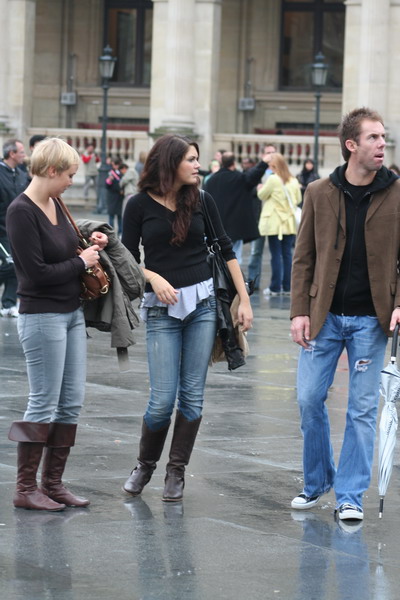
Even the security guards ride bikes here. I love it!
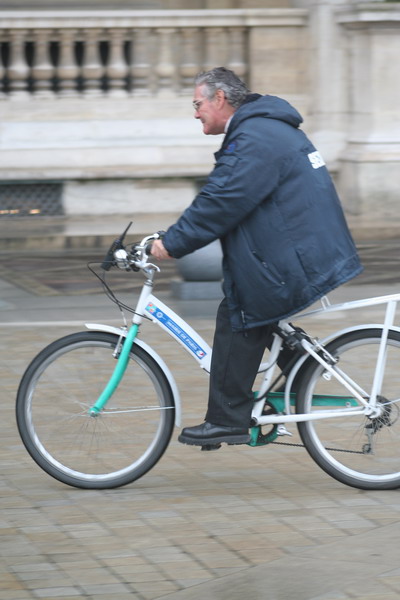
Here’s an aerial view of the entrance courtyard of the Louvre. As you can see, it’s dominated by the glass pyramid built in 1989. It’s a sharp contrast to the rest of the architecture. Personally, I think it’s a nice contrast. It stands about 70 feet high and serves as the main entrance.
Also interesting to note that since Dan Brown’s book the Da Vinci Code was published in 2003 (which opens in the Louvre and this pyramid plays a central role in the plot) visits to the museum have dramatically increased. In fact in 2005, there were 7.3 million visitors, a 22% increase to previous figures. That makes the Louvre the most popular tourist attraction in Paris.

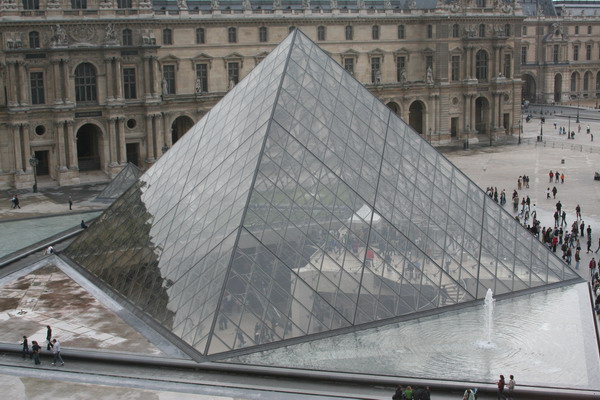
Inside, we toured as much of the palace as we could, but since there are 73,000 works of art, we simply couldn’t see it all in a day. However, in my pictures below, you will notice that I have more of the sculpture. That’s not to mean that I didn’t enjoy the paintings and other works of art, it simply reflects that it’s easier to create an artistic image with sculptures. Plus, if you merely want to see the work of art, the Louvre publishes most of them on their website: http://www.louvre.fr/llv/musee/alaune.jsp
This is one sphinx of Ramses II (a similar larger version of this is in Egypt as well, in addition to the Great Sphinx of Gaza).
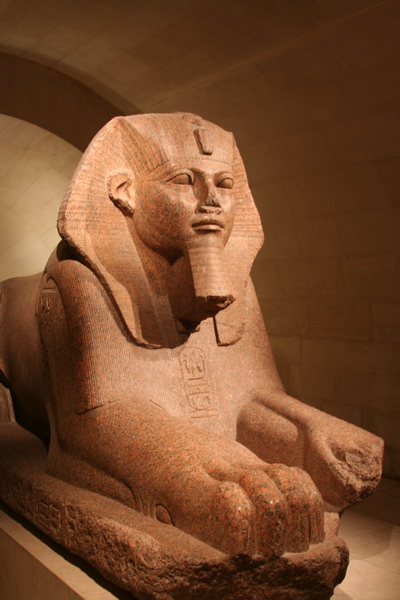
A statue of the Roman Emperor Constantine. He’s notable because he made Christianity the state religion of Rome and he began his rule nearby us in Trier before he went on to found the city of Constantinople.
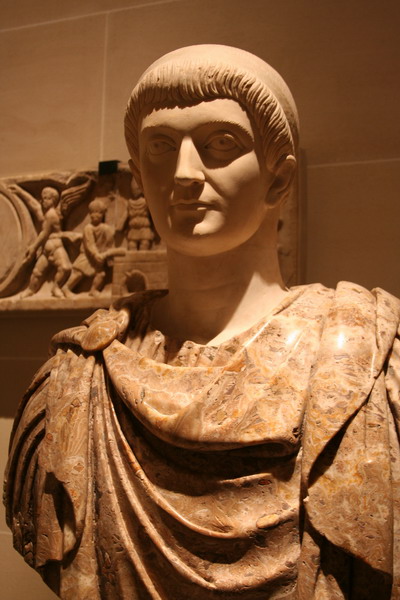
Here’s Anna wandering the halls (which is a work of art by itself)…
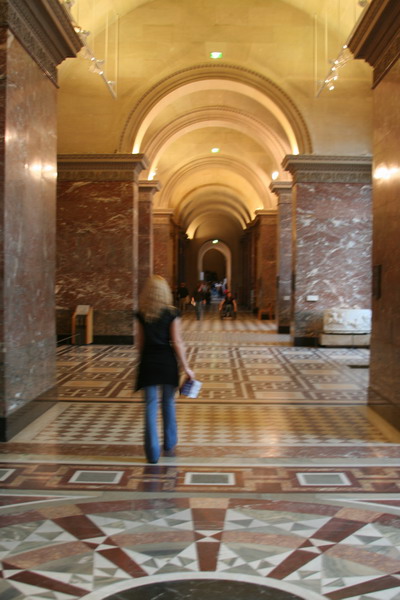
Of course we had to see Da Vinci’s Mona Lisa and the Venus de Milo. While we didn’t take any pictures of the Mona Lisa (the crowd surrounding it is perhaps the most impressive part). However, below is the ancient Greek sculpture probably depicting Aphrodite and most likely created by Alexandros of Antioch. However, since the arms and pedestal are missing no one is entirely sure on either count. I’ve always found it interesting a work of art can gain such fame without really knowing where it came from… 🙂

The crowd around the Venus de Milo was almost as large as the Mona Lisa.
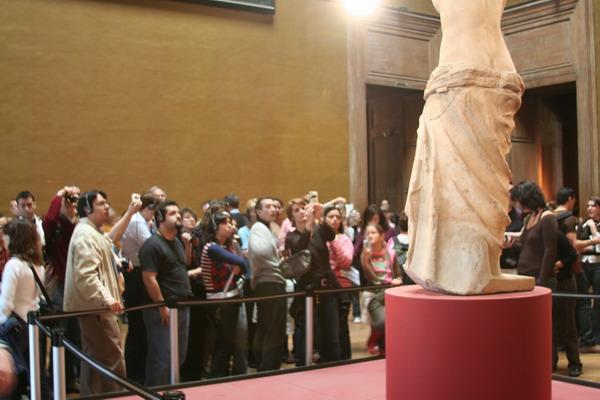
A self portrait…
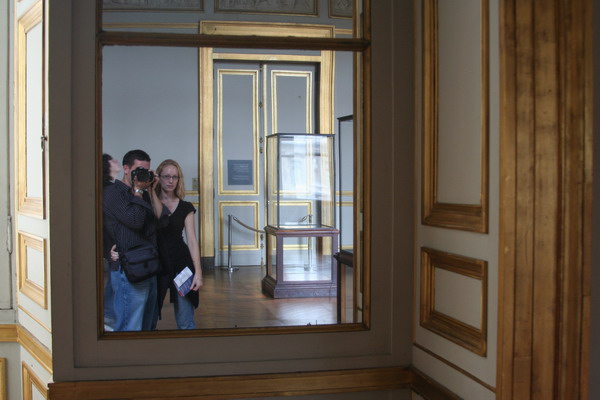
Another wing…
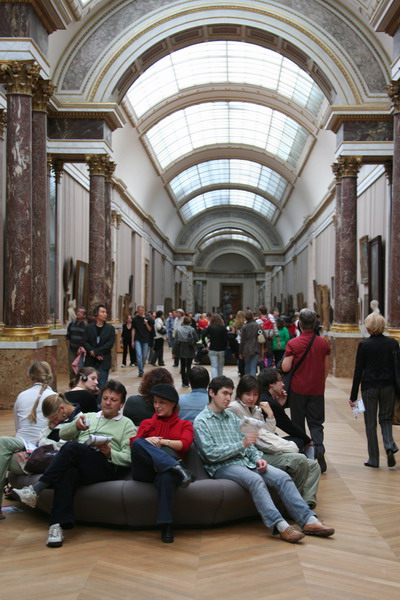
A whole room of art… 🙂
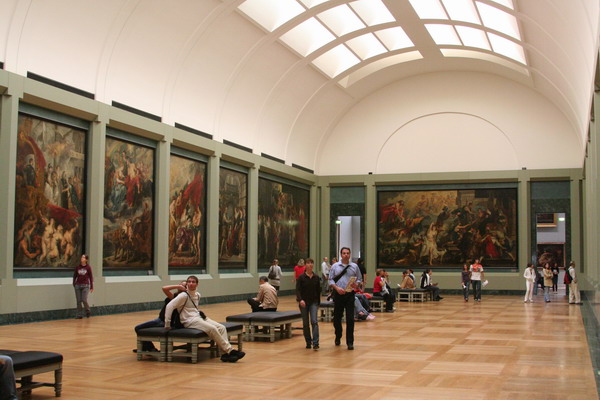
The father of our nation (George Washington) in the foreground and a like-minded, sharp-witted French philosopher from the same era (Voltaire) in the back.
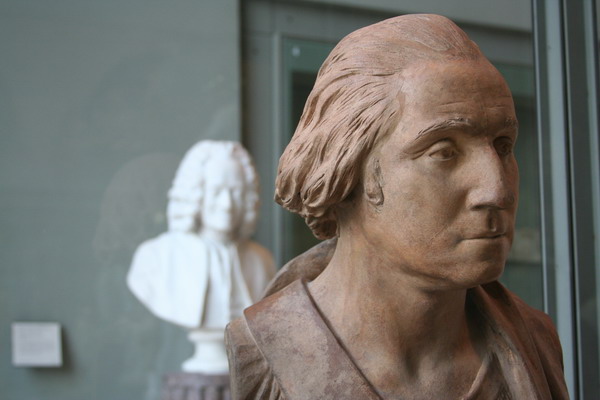
My favorite museum-going partner.
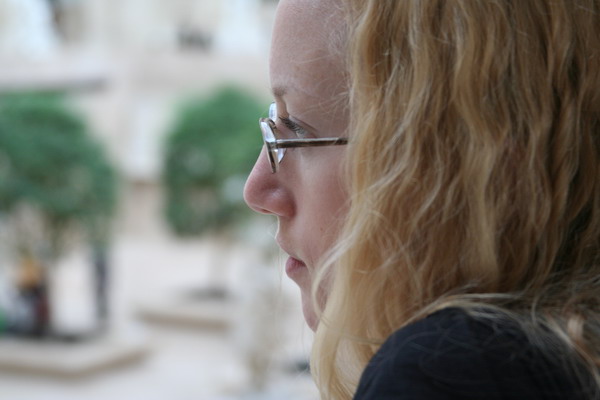
This eight-foot tall stela of basalt is the codified laws of Hammurabi of ancient Mesopotamia (from about 1780 BC). There are 282 laws written on this stone. We found it fascinating in that it is one of the earliest sets of laws. Since the laws were carved into the stone, they were immutable and irrefutable. Also, supposedly, this is also where the term written in stone came from.
Not only is fascinating from a legal and social perspective, it is also quite a beautiful work of art.
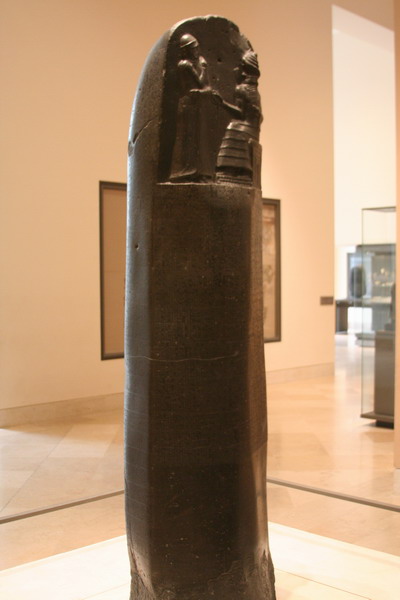
Finally, there was a scary lion from Mesopotamia to complete our tour of the Louvre.
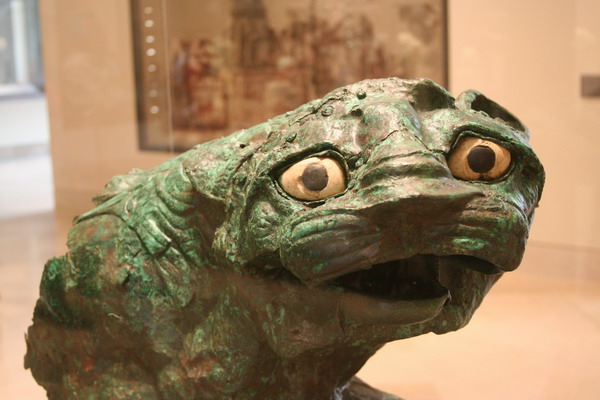
It was simply an amazing weekend to celebrate Anna’s birthday. Best of all, it was only a four-hour drive away!
So, until the next adventure…
–Jim
